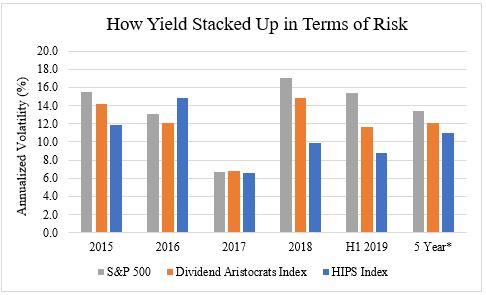Are You Actually Set up for Income?
Posted:
In the shifting sands of today’s market, finding sustainable income may be one the most challenging, yet pervasive concerns for investors. More troubling yet, market watchers may think they are positioned in income or dividend-oriented strategies, only to realize these approaches may deliver only marginally more income than the broad market.
The low yields of supposedly high-income strategies may have become a staple in this market regime. Further compounding the problem is that the Fed is widely expected to cut rates, with markets according to Bloomberg pricing a 99.9% chance of at least one cut in 2019, and 93% probability of two or more. What is a saver to do when searching for higher yield?
Finding Yield in the Desert
This dearth of income has refocused the paradigm on retirement, forcing advisors and clients to reevaluate lifestyle goals within the context of the possible, hemmed in by low yields. What if there were an index that achieved 4 times the yield of the S&P 500 with less volatility? This result is precisely what the reengineered TFMS HIPS Index achieved, delivering an 8.91% yield as of June 30th, 2019. For perspective, the S&P 500 yielded 1.91%, and the popular S&P 500 Dividend Aristocrats Index realized 2.44% over the same timeframe. While indexes are not directly investable, their performances can be indicative of the varying options available to investors in meeting their financial goals.
Hence, volatility control is a guiding impulse in not only security selection, but in asset allocation as well.
In a market where every basis point counts, the 53 bp premium offered by the Dividend Aristocrats Index over the S&P 500 is certainly better than nothing, but this level of yield may still not be sufficient for all investors. To this end, the TFMS HIPS Index delivered over eleven and a half times as much of a yield increase over the S&P 500 as the Dividends Aristocrats Index managed. A 700 basis point yield premium over the broad market offers advisors, and investors, a powerful tool for augmenting portfolio income. While past performance is certainly no guarantee, higher yields may offer more options in the context of long-term wealth-management, a potential solution in the yield desert.
Hitting Your Mark
How has the recalibrated HIPS Index accomplished this feat? The strategy scours the combined U.S. alternative income ecosystem, comprising Master Limited Partnerships (MLPs), Closed-End Funds, Business Development Companies (BDCs) and Real Estate Investment Trusts (REITs), some 940 instruments in total. Importantly, these categories feature pass-through income structures, which distribute substantially all their earnings to investors before taxes, thus avoiding the double taxation phenome.
From this universe, the HIPS Index distills up to 60 securities that are both the highest yielding and the least volatile in their category over the last year. This second criterion seeks to generate very high levels of income in as risk-efficient manner as possible. Significantly, risk-efficient performance does not imply risk-free investment—risk is an inherent feature of the investing process, the aim being to budget risk so as to maximize potential investor outcomes.
 Notes: Sourced from Bloomberg, JWC Research. Annualized volatilitymeasured by standard deviation. *5-year period ends 6/30/19.
Notes: Sourced from Bloomberg, JWC Research. Annualized volatilitymeasured by standard deviation. *5-year period ends 6/30/19.The chart above details how the HIPS Index over the long-term experienced substantially less volatility than both the S&P 500 and the income-focused Dividends Aristocrats Index. Over the past 5 years ending H1 2015, the HIPS Index assumed 225 basis points less risk than the broad market.
Risk management informs not only the initial volatility screen, but it involves further controls at each step throughout portfolio construction. For instance, exposure to each of the four fund categories is determined using Minimum Variance Optimization, a classic application of Markowitz’s Modern Portfolio Theory. After determining sector weights, all assets within a given sector are equal weighted. From the outset not only are the least volatile securities picked, but sectors are subsequently weighted to take advantage of their cross-correlations. Hence, volatility control is a guiding impulse in not only security selection, but in asset allocation as well.
Perhaps just as important as the nominal yield of an income strategy, however, is the source of the yield—too often the question is “how much” instead of “from where.”
Finally, the sector weights are subject to constraints to not only maintain a balance of exposures, but to further curtail the potential for volatility. For instance, MLPs are limited to a maximum 25% allocation to ensure the portfolio does not become overly dependent on energy risk for return contribution. Moreover, each fund category has a 15% floor, so the practical maximum for the other non-MLP sectors is 55%. This system seeks a happy medium of preventing the phenomenon of token exposures (assets with de minimus weightings) while also averting a single sector from hijacking the index; balance is key. Employing these methodologies is not to suggest that risk is made sterile, but merely that a diversified approach may limit over-reliance on any one type of risk.
It’s 10PM—Do You Know Where Your Yields Are?
In its purest form, income generation tends to be a strategy in it for the long haul, where daily mark to market fluctuations may be less important than sustainable, and sizeable, cash distributions. Nonetheless, lower volatility can clarify the use-case of high income strategies, whether in augmenting an equity sleeve’s yield, diversifying fixed income exposure, or even serving as a standalone allocation. For instance, consider the results of blending the HIPS Index into the equity portion of a standard 60/40 model portfolio. As of June 30th 2019, a 10% HIPS Index allocation would have boosted the equity sleeve’s yield by 62%, while also reducing volatility by 125 bps over the past year.1
Perhaps just as important as the nominal yield of an income strategy, however, is the source of the yield—too often the question is “how much” instead of “from where.” In searching for yield, many investors will double down on the same risks, be it duration, credit, interest rate or even sector risk, instead of diversifying their income footprint.
Related: Your 60/40 May be Broken, But Not for the Reasons You May Think
For instance, the well-known iBoxx US Liquid High Yield Index held a whopping 88% allocation to the industrial sector as 6/30/19. Not only do the four sectors of HIPS Index seek out a different series of exposures, but these pass-through securities have historically maintained low correlations with standard fixed income risks. The fact of the matter is many investors may be underexposed to alternative income solutions, simply because they fall outside the framework of common market indices.
What Does Income Mean to You?
In practical terms, the opportunity for higher income through retirement years affords greater financial freedom, alleviating the need for aggressive saving in the present or sacrificing lifestyle support in the future. Significantly, the recrafted HIPS Index may facilitate these goals with a two-fold impact, a renewed focus on dampening volatility and on diversifying portfolio exposure. Seeking higher yields can involve trade-offs and additional risks, and the HIPS Index seeks a systematized approach for calibrated exposure to alternative income.
1 The referenced model 60/40 portfolio features a 60% allocation to the S&P 500 Index, and a 40% allocation to the Bloomberg Barclays U.S. Aggregate Bond Index, a broad-based benchmark that measures the investment grade, US dollar-denominated, fixed-rate taxable bond market. The index includes Treasuries, government-related and corporate securities. Volatility is represented by annualized standard deviation.
One cannot invest directly in an index. Past performance is not a guarantee of future returns. Diversification does not guarantee profit or loss prevention.
The TFMS HIPS Index measures the returns of high-income U.S. listed securities that typically have “pass-through” structures that require them to distribute substantially all of their earnings through cash dividends. The S&P 500 Dividend Aristocrats index is designed to measure the performance of S&P 500 index constituents that have followed a policy of consistently increasing dividends every year for at least 25 consecutive years. iBoxx US Liquid High Yield Index measures US dominated, sub-investment grade, corporate bond market. The Index includes bonds with a minimum 1 years to maturity, with bond types including fixed-coupon, step-up, bonds with sinking funds, medium term notes and callable and puttable bonds.
A Basis Point is one hundredth of one percent (0.01%).

